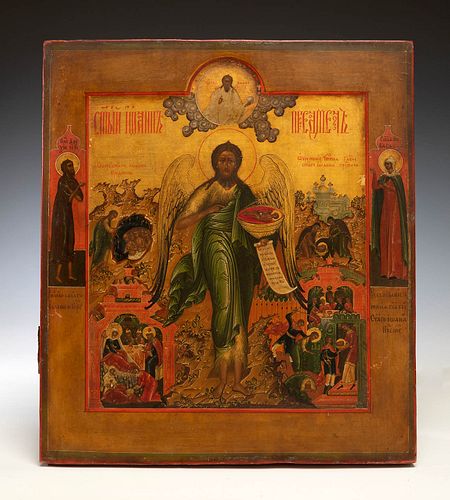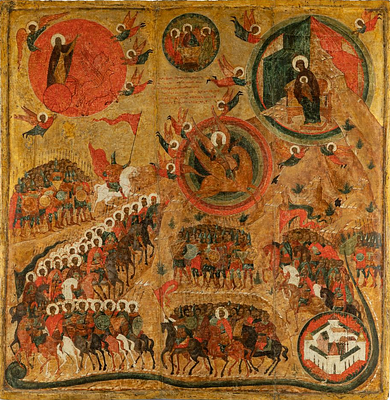Russian school, Old Believers' workshops, probably Mstera school, late 18th century. "Saint John the Baptist in the desert, with the child Jesus in th
Lot 51
About Seller
Setdart Auction House
Carrer Aragó 346
Barcelona
Spain
Setdart Subastas was born in 2004 and is currently the first online art auction in Spain with solidity, prestige and reliability guaranteed by our more than 60,000 users. Setdart has a young, dynamic and enterprising team ready to successfully manage the purchase and sale of art works through custom...Read more
Estimate:
EUR€4,000 - EUR€5,000
$4,301.08 - $5,376.34
Absentee vs Live bid
Two ways to bid:
- Leave a max absentee bid and the platform will bid on your behalf up to your maximum bid during the live auction.
- Bid live during the auction and your bids will be submitted real-time to the auctioneer.
Bid Increments
| Price | Bid Increment |
|---|---|
| EUR€0 | EUR€10 |
| EUR€200 | EUR€25 |
| EUR€500 | EUR€50 |
| EUR€1,000 | EUR€100 |
| EUR€3,000 | EUR€200 |
| EUR€5,000 | EUR€500 |
| EUR€10,000 | EUR€1,000 |
| EUR€20,000 | EUR€2,000 |
| EUR€50,000 | EUR€5,000 |
About Auction
By Setdart Auction House
Sep 23, 2021
Set Reminder
2021-09-23 10:00:00
2021-09-23 10:00:00
America/New_York
Bidsquare
Bidsquare : RUSSIAN ICONS
https://www.bidsquare.com/auctions/setdart-auction-house/russian-icons-7431
Setdart Auction House sofia@setdart.com
Setdart Auction House sofia@setdart.com
- Lot Description
Russian school, Old Believers' workshops, probably Mstera school, late 18th century. "Saint John the Baptist in the desert, with the child Jesus in the baptismal shell". Tempera on wood. Measurements: 35 x 31 cm. The representation of St. John the Baptist as a hermit, with the wings of an angel, and with a parchment, is related to the evangelical testimonies about St. John, as a prophet. The depiction of St John in the desert is a Byzantine iconography that developed towards the end of the 13th century. In Russian iconography, such images begin to be found from the second half of the 14th century, but they gained their greatest popularity from the second half of the 16th century onwards, as he was the patron saint of Ivan the Terrible. The auctioned icon depicts a canonical image of St John standing in the desert. In his right hand he holds the baptismal shell with the infant Jesus in it, as a reference to his role as a baptiser. In the background are four miniatures depicting the life of St John, beginning with the birth of St John in the lower left corner. This is followed by the upper left image, which depicts St John as a prophet. The cycle ends with two images of his death: in the lower right corner is the detailed image of his martyrdom, and above it is the apparition of St John's head. Precisely these two miniatures indicate almost clearly the school of the icon, which is most probably the school of Mstera, and its belonging to the workshops of the Old Believers. Firstly, the detailed representation of the martyrdom of St John is a characteristic feature of the icons of the Old Believers. The depiction of the act in several scenes, with blood and with the head to the side, symbolises the actual decapitation of the Orthodox Church in the eyes of the Old Believers after Nikon's reforms. The miniature in the upper right corner, on the other hand, depicts a five-domed church with a topographical character. It appears almost like a theatrical decoration. On both sides of the central image are the representations of Alexius of Rome on the left, and of the martyred saint Vassa, whose three sons took the martyr's death and, like Saint John, were beheaded. They are depicted with a brushed background, another of Mstera's characteristic details. The composition ends with the representation of the Pantocrator in a white chiton, symbol of purity and celestial power, with a blessing with two fingers, and the orb crowned with the eight-pointed cross. This is another sign of the icon's connection with the workshops of the Russian Old Believers. The Old Believers were a group of Orthodox who, after Nikon's church reforms of 1654, decided to follow their opponent Avvakum, defending the traditional foundations of the Orthodox Church. Fleeing persecution, they settled in the villages of Pomorie, near the Urals and in Siberia, although by the 18th century they began to settle in the northern areas near Moscow. The Old Believers' Faith was legalised as early as 1905, which sparked an interest in the Russian Empire in the discovery of the national religious heritage, as well as the development of collecting ancient icons, which had never been experienced before.
- Shipping Info
-
In-house shipping available. Please inquire at admin@setdart.com.
-
- Buyer's Premium



 EUR
EUR CAD
CAD AUD
AUD GBP
GBP MXN
MXN HKD
HKD CNY
CNY MYR
MYR SEK
SEK SGD
SGD CHF
CHF THB
THB
















